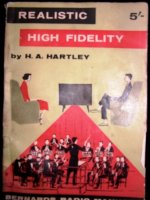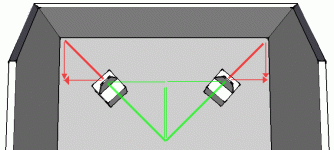Considering the above I'm beginning to get hints why an approach called 'flooder' could have any change of stereophonic imaging. Who could have thought.. 🙄
- Elias
- Elias
Hooked up the TIE fighter to my AVR together with 2 subs and ran Audyssey MultEQ. Pretty amazing for a speaker made from cardboard. The Stereosphere™ principle is working.
I should have done these tests two years ago, I could have saved all this time with a greater knowledge. Speculation leads to nothing.
It's a big step for an individual to try something which does not make sense according to the his previous knowledge about the subject. It takes extraordinary curiosity to break the chains of conventionalism.
Elias, what can I say? 😀
I will only add a short quote from Albert Einstein: If at first, the idea is not absurd, then there is no hope for it 😎
I have to say that You - both of You, Markus included, are doing very fine job
I am impressed and grateful
Same perceptual results. No distinct phantom image with Stereolith.
that was brilliant move Markus, those tests conclusively falsify the hypothesis that back-to-back operation relies on the presence of ITD cues in recording!
that is really
a breakthrough !
it's truly quod erat demonstrandum 😀
This is crazy, you must be in the diffuse field to get imaging out of this system ! 😱 I got imaging from all the samples.
funny thing is that I have been writing about this craziness for years 😎
I am especially happy as Markus' experiment and Your listening tests seem to corroborate my initial hypothesis that back-to-back operation doesn't rely on the type of stereophonic cues - both intensity and time can work
I want to know which book explains this?
certainly not Toole's... right Markus? 😉
You must try it by yourself.
AMEN! 😎
blessed are those who dare to try 😉 audaces fortuna iuvat!
To the the sonic information in the source material.
to put it shortly - what is the value of such defined fidelity? for a human person, music lover seeking enjoyment in music at home?
Frequency, amplitude, phase, etc all need to be reproduced accurately at the listeners ears if Hi-Fidelity is to be achieved.
such abstract, technical concept of Hi-Fidelity I consider to be a very unfortunate deviation from the original concept
it was H.A. Hartley who "invented the phrase "high fidelity" in 1927 to denote a type of sound reproduction that might be taken rather seriously by a music lover"
He understood it as realistic high fidelity, high fidelity = realism of sound reproduction
fidelity to the human experience of the real thing
more on the subject:
http://www.diyaudio.com/forums/multi-way/121385-loudspeakers-room-system-55.html#post2096961
I only point out that the stereolith concept, (as independently verified by others here, including on the real stereolith), generally does not place lateral images accurately.
really? don't You think that with this conclusion You are a bit too fast? 😉
as for verifications - read the whole thread not just couple of last pages and please - don't treat my verifications as dependent, hope I am not asking too much 🙂
best regards,
graaf
Attachments
Considering the above I'm beginning to get hints why an approach called 'flooder' could have any change of stereophonic imaging. Who could have thought.. 🙄
yes who could have thought 😉 while a few of those that dared to try it have already heard it
please let's continue the flooder topic in the original thread 🙂
best,
graar
Markus,
Did you notice the distance dependency on imaging with the stereolith or the cardboard?
How is your layout?
My room is 3.5*7 m. Cardboard is placed in a longitudal centerline about 1 m from the front wall. I listened at 2 - 5 m from the box.
Your demo samples don't image at 2m distance. BUT they image at 3-5 m distance!
Time to open the 'book' or continue the tests? 😀
- Elias
Did you notice the distance dependency on imaging with the stereolith or the cardboard?
How is your layout?
My room is 3.5*7 m. Cardboard is placed in a longitudal centerline about 1 m from the front wall. I listened at 2 - 5 m from the box.
Your demo samples don't image at 2m distance. BUT they image at 3-5 m distance!
Time to open the 'book' or continue the tests? 😀
- Elias
I don't have the album so I have to settle to youtube.
I like ! Very nice with the cardboard.
I like ! Very nice with the cardboard.
Listen to Sting's "The Soul Cages" - you'll like it. It's mixed in QSound.
Hooked up the TIE fighter to my AVR together with 2 subs and ran Audyssey MultEQ. Pretty amazing for a speaker made from cardboard. The Stereosphere™ principle is working.
great! 😀 what is exactly pretty amazing about it?
Do You mean AVR + an upmixing algorithm?
graaf, I don't agree with your conclusions. There's more to it.
Could You be a little bit more specific? Which conlusions exactly?
What is more to it?
Both!
which book?
Markus,
Did you notice the distance dependency on imaging with the stereolith or the cardboard?
How is your layout?
I would also like to know 🙂
My room is 3.5*7 m. Cardboard is placed in a longitudal centerline about 1 m from the front wall. I listened at 2 - 5 m from the box.
Your demo samples don't image at 2m distance. BUT they image at 3-5 m distance!
great observation! This explains why I never experienced such a failure of back-to-back box - I simply never listened to it closer than about 3.5 m 😀
Yet another breakthrough !
You must get rid of the direct sound for the principle to work correctly. I blocked the direct sound by a soffa pillow, and the distance dependency on imaging is no more ! Every distance is good now.
Now I'm listening to this:
Look at the pic. Is this high fidelity?! 😀
😀
Should I wake up from this dream and not to remember this.. I almost cannot believe this is happening. This is totally absurd 😎
- Elias
You must get rid of the direct sound for the principle to work correctly. I blocked the direct sound by a soffa pillow, and the distance dependency on imaging is no more ! Every distance is good now.
Now I'm listening to this:
An externally hosted image should be here but it was not working when we last tested it.
Look at the pic. Is this high fidelity?!
 😀
😀Should I wake up from this dream and not to remember this.. I almost cannot believe this is happening. This is totally absurd 😎
- Elias
Yet another breakthrough !
You must get rid of the direct sound for the principle to work correctly. I blocked the direct sound by a soffa pillow, and the distance dependency on imaging is no more ! Every distance is good now.
Now I'm listening to this:
Look at the pic. Is this high fidelity?!😀
Should I wake up from this dream and not to remember this.. I almost cannot believe this is happening. This is totally absurd 😎
- Elias
yeah!




and in fact it is still the old reinventing the wheel 😀
take a look at this:
AES E-Library A Compact, Single-Cabinet, Stereophonic Speaker System
Deflector baffles in the form of doors are used to reduce the sound reaching the listener directly from the speakers. The sound fields so created are continuous, and thus provide good -center fill- without additional speakers.
behind this concept no crazy pseudoscientists oh no! just old school engineers, open-minded, Victor Brociner among them

best!
graaf
Markus,
Try adding stereo reverb for the sound samples you posted today, and listen with stereolith or cardboard.
There will be a new revelation waiting !
- Elias
Try adding stereo reverb for the sound samples you posted today, and listen with stereolith or cardboard.
There will be a new revelation waiting !
- Elias
and in fact it is still the old reinventing the wheel 😀
take a look at this:
AES E-Library A Compact, Single-Cabinet, Stereophonic Speaker System
Yes, my regular trademark 😎
Great find from the AES. Looks like the developments in audio has been halted since 1950's 🙄
Those were the days when computer simulations were not available and everything had to be tried by hand. Also not many books on the subject available at that time, so also no prejudices on what works and what do not.
Of course nowadays everything is better 🙄 We have computers and a lot of prejudices 😀 Everything is too easy by a click of a mouse. No more true pioneering spirit.
- Elias
Markus,
Try adding stereo reverb for the sound samples you posted today, and listen with stereolith or cardboard.
There will be a new revelation waiting !
- Elias
🙂
(...)
fails miserably with incompatible recordings
without distance/ambience cues in the recording - without natural or artificial reverb - it produces literally no soundstage
it was very frustrating
now I think that perhaps a reverb processor could help in case of such defective recordings?
(...)
Try adding stereo reverb for the sound samples you posted today, and listen with stereolith or cardboard.
Already did that with mixed results. I also found a way to position phantom sources. Have to check how stable this is.
I haven't yet tried the sound samples Markus delivered, but I remember a discussion between Elias and me from last year, where we could not find a common view on hearing a phantom center with the head turned.
In the light of todays discussion I like to talk about my own system which has delivered that "phantom with turned head" for quite a while. It is a dipole system with the back firing into the room corners:

As the vector arrows show, there is a strong component of sound firing to the side walls in "stereolith fashion". The difference to many other systems is, that I insist on having the (almost) same response curve in all directions (not level, but frequency distribution). So - as in stereolith - my reflections from the side walls are not dull caricatures of the original, but have the same frequency content - only at a lesser level. Omnis tend to have the same sort of frequency congruent reflections.
Could it be that you don't necessarily need that stereolith construction, but only some decent polar response of your system, including a nice share of ipsilateral and contralateral reflections?
Rudolf
In the light of todays discussion I like to talk about my own system which has delivered that "phantom with turned head" for quite a while. It is a dipole system with the back firing into the room corners:
As the vector arrows show, there is a strong component of sound firing to the side walls in "stereolith fashion". The difference to many other systems is, that I insist on having the (almost) same response curve in all directions (not level, but frequency distribution). So - as in stereolith - my reflections from the side walls are not dull caricatures of the original, but have the same frequency content - only at a lesser level. Omnis tend to have the same sort of frequency congruent reflections.
Could it be that you don't necessarily need that stereolith construction, but only some decent polar response of your system, including a nice share of ipsilateral and contralateral reflections?
Rudolf
Attachments
- Home
- Loudspeakers
- Multi-Way
- Stereolith Loudspeakers Question

